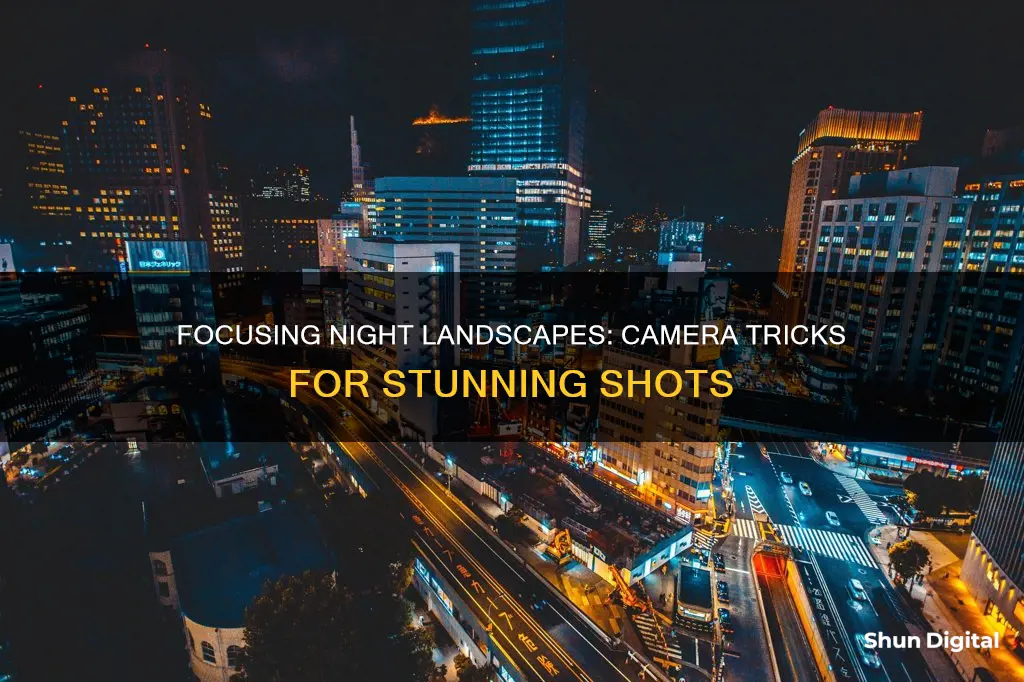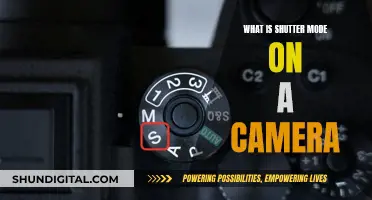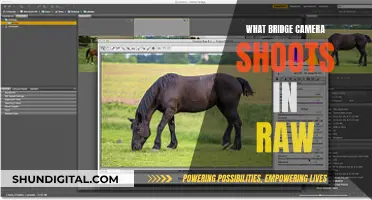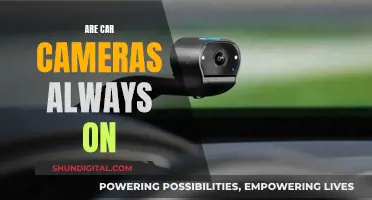
Focusing a camera at night for landscape shots can be challenging. The autofocus feature on modern cameras is unreliable in dark sky conditions. To capture sharp images, photographers must rely on manual focusing techniques. Here are some tips to achieve accurate focus when photographing at night:
- Use manual focus mode: Switch your camera or lens to manual focus mode, as it allows for more careful and precise control over the focus.
- Pre-set the lens to the infinity mark: While not always accurate, setting the focus to infinity can give a decent starting point.
- Enable Live View: Use the Live View mode on your DSLR or mirrorless camera to amplify and magnify the scene, making it easier to frame and focus on bright stars or light sources.
- Pre-set the exposure: Set your camera to manual mode and input the desired exposure settings before framing your shot.
- Centre a bright star or distant light source: Focus on the brightest star or light source in the sky, zooming in if necessary, to ensure it appears sharp and pinpoint-like.
- Use a flashlight or headlamp: Illuminate your scene or place the light source at the desired distance to assist with autofocus or manual focus.
- Use back-button focus: Set your camera to trigger focus when a button on the back is pressed, rather than when the shutter button is pressed halfway down.
- Use a high aperture value and wide-angle lens: This creates a wider depth of field, increasing the range of sharp focus in your frame.
- Take test shots: Review your images on the LCD screen, zooming in to check the focus. Make adjustments as needed until you achieve the desired results.
| Characteristics | Values |
|---|---|
| Time of day | 2 hours after sunset |
| Time of year | April until late September |
| Location | Rural, away from light pollution |
| Camera features | Proper ISO management, self-timer/mobile app connectivity |
| Camera accessories | Wide-angle lens, tripod, filters |
| Clothing | Thermal layers, coat, gloves, socks, beanie |
| Other equipment | Torch, headlamp, camera bag, water bottle, snacks |
| Camera settings | Manual focus, RAW format, self-timer/remote |
| Camera focus | Brightest star, moon, nearby ground feature |
| Camera exposure | ISO 800-1600, aperture f/2.8, shutter speed 1-30 seconds |
What You'll Learn

Use manual focus
Capturing sharp images at night can be challenging, but using manual focus can help you get the best results. Here are some tips for using manual focus in night landscape photography:
- Use Live View: Activate Live View on your camera to see more of the landscape. Increase the ISO, shutter speed, and open the aperture to improve visibility. Even though you won't see the entire scenery, you'll be able to see outlines of the landscape and the brightest stars, which can help you compose your shot.
- Find a Bright Spot: Look for a bright spot in your scene, such as the brightest star, a streetlight, or another light source. This will be your focal point. Use the buttons on your camera to zoom in on this spot and adjust your focus until it is sharp.
- Prefocus on Infinity: If you don't have Live View, you can still get sharp photos by pre-focusing your camera on infinity before heading out. Mark the spot with a pen or tape the focus ring to keep it from moving.
- Hyperfocal Distance: This is a more advanced technique than focusing on infinity, and it can result in slightly sharper images. It requires some calculations to determine the optimal focusing distance for your specific camera and lens combination.
- Use a Tripod: Set up your camera on a sturdy tripod to provide stability and allow for more precise focus adjustments.
- Remote Shutter Release: Avoid touching the camera when taking the shot to prevent camera shake. Use a remote shutter release, such as a cable or infrared release, or set your camera's self-timer.
- Practice: Focusing in night photography takes practice, so don't be discouraged if you don't get perfect results right away. Experiment with different settings and techniques to improve your skills.
Understanding Camera Raw: Processed or Not?
You may want to see also

Focus on the brightest star
Focusing on the brightest star is a great way to ensure your night landscape shots are sharp and in focus. Here is a step-by-step guide to achieving this:
Use Live View
If your camera has a Live View function, activate it. This will allow you to see more of the landscape when you increase the ISO, shutter speed, and aperture. You won't be able to see the entire scenery, but you will be able to make out the outlines of the landscape and the brightest stars.
Find a Bright Spot
Use Live View to locate a bright spot in the sky, such as the brightest star, or another light source like a streetlight. This will be your focal point.
Zoom In
Use the buttons on the back of your camera to zoom in on the bright spot you have chosen.
Manual Focus
Even if your camera has autofocus, it is best to switch to manual focus for night photography. In manual mode, adjust the focus ring until the spot becomes sharp. You may need to twist the ring back and forth a few times to find the exact point of focus.
Take Test Shots
Take a few test shots to adjust and find the best perspective and composition. It can be challenging to get this right on the first try, as it can be difficult to see the landscape in the dark.
Lock Your Focus
Once you have achieved focus, lock it down by taping the focus ring with gaffer's tape. This will prevent the focus from accidentally shifting.
Check Your Focus Regularly
Remember to check your focus after a few shots to ensure it is still accurate.
Tips:
- If you don't have Live View, you can still achieve sharp photos by using the techniques mentioned above and taking a few extra test shots.
- If you are including the moon in your composition, you can focus on it to acquire proper focus on the stars.
- If there are no bright stars or the moon visible, you can use a bright flashlight to shine on an object in the distance and focus on that.
- It is important to dress warmly and bring safety gear when shooting night landscapes, as it can get very cold.
- Consider bringing a fellow photographer with you for safety and company.
With these techniques, you'll be well on your way to capturing stunning night landscape shots with sharp focus on the brightest star!
Finding the Battery on Your Fujifilm Waterproof Camera
You may want to see also

Use Live View
Live View is a feature found on most DSLR cameras. It allows you to see your subjects on the back screen of your camera, rather than through the viewfinder. It also lets you preview the focus and exposure before you take a shot.
To enter Live View, find the button on the back of your camera that looks like a little camera with a black square in the middle.
Using Live View, you can see more of the landscape when you increase the ISO and shutter speed, and open the aperture. You won't be able to see the entire scenery, but you can see the outlines of the landscape and the brightest stars. This will help you to find the best perspective and composition.
Live View is particularly useful for getting sharp focus. You can zoom into your scene and set your focus exactly where you want it. First, find a bright spot on your LCD screen, such as the brightest star, a streetlight, or another light source. Then, use the +/- buttons on the back of your camera to zoom in on this spot. Finally, adjust the focus ring until the spot is as sharp as possible.
Live View is also useful for composing your shot. You can see your landscape composition right before your eyes, and adjust accordingly. Most cameras' Live View mode also shows 100% of the scene, whereas many optical viewfinders show a slightly cropped scene. Some cameras will also display composition assist grid lines during Live View, so you can see if your composition is balanced.
In addition, Live View can be helpful for setting your camera's exposure. You can access all of your settings in Live View, and see your histogram alongside your composition.
However, Live View does have some drawbacks. It can drain your battery, and it can be hard to see the screen in bright sunlight or at night.
Smart Doorbell Camera Options Without Monthly Fees
You may want to see also

Use a flashlight to assist with autofocus
Using a flashlight to assist with autofocus is a great way to get sharp night landscape shots. Here are some tips on how to use this technique effectively:
- Use a flashlight to illuminate your scene and provide enough light and contrast for your autofocus system to operate accurately. This is especially useful when photographing in very dark locations or when your camera struggles to find a reference point.
- Place the flashlight at the desired distance for achieving focus. Shine the light on your subject or the area you want to be in focus. This will help your camera focus on that specific area.
- Adjust your camera settings to use autofocus. Change your focus mode to AF-S (Single Servo/Single Area AF) to ensure the flashlight is only used for focusing and not for continuous subject tracking.
- Half-press the shutter button or use the AF-ON button to activate the autofocus. The camera will now focus on the area illuminated by the flashlight.
- Once the camera has focused, you can turn off the flashlight and compose your shot. Keep the camera settings and focus locked to ensure you don't lose the focus point.
- Take the photo. With the flashlight assisting your autofocus, you should now be able to capture sharp and focused night landscape images.
Using a flashlight as an autofocus assist tool is a simple yet effective technique. It helps your camera focus in low-light conditions and ensures you get clear and crisp photos, even in challenging lighting situations. Remember to experiment with different flashlight positions and camera settings to find the best results for your specific scenario.
Charging the Fujifilm XP80: A Step-by-Step Guide
You may want to see also

Use back-button focus
Back-button focus is a camera technique that separates focusing and shutter release into two distinct functions, with one button dedicated to each. This is a useful way to prevent the camera's autofocus system from continuously engaging when the shutter is released.
By default, the shutter button at the front of the camera is set up to perform two functions: focusing the scene (when you half-press the shutter button) and releasing the shutter (when you fully press the shutter button). With back-button focus, you assign the autofocus function to a dedicated button on the back of the camera, usually the AF-ON button. This means that the camera will only focus when you press the back button and will only capture the image when you press the shutter button.
Back-button focus is particularly useful for night landscape shots as it allows you to lock in the focus separately before capturing the image. This prevents the camera from hunting for focus in low-light conditions, which can result in blurry images. With back-button focus, you can increase the ISO and extend the shutter speed temporarily so that the camera gets a clearer/brighter view of the scene. Once you have achieved focus, you can change the ISO and shutter speed back to the correct exposure settings to take the photo.
There are several benefits to using back-button focus. Firstly, it gives you greater control over the camera's critical functions, allowing you to lock in the focus and exposure settings before pressing the shutter button. Secondly, it eliminates the delay caused by the camera refocusing when you press the shutter button, ensuring that you capture the moment you intended. Thirdly, it allows you to switch seamlessly between auto and manual focus, and between continuous and single focus, without changing modes. Finally, it improves your workflow by simplifying the process of focusing and capturing an image.
However, there is a learning curve associated with back-button focus. It may feel awkward and unnatural at first, and it requires excellent coordination to operate fluidly. It takes time and practice to master the technique, particularly in challenging shooting conditions such as cold weather.
New Camera Battery Died? Here's Why
You may want to see also
Frequently asked questions
Escape light pollution by avoiding urban and inner-city locations. Instead, opt for rural and country areas. Research the appearance of the moon and the Milky Way at your chosen location. Having natural ground elements, such as a lake or mountain range, will enhance your composition.
A camera with proper ISO management is ideal to avoid image noise. A self-timer, remote camera app, or physical shutter release cord will also help you avoid image blur. A wide-angle lens with a wide aperture of around f/2 is recommended. Additionally, bring a sturdy tripod, light pollution filters, and extra camera batteries and SD cards.
Night photography can be cold, so dress appropriately with thermal layers, a high-quality coat, gloves, thick socks, and a beanie. Ensure you have a powerful torch and a headlamp to illuminate your path and assist with focus. Research the location and local wildlife, and always let someone know where you're going.
Use manual focus rather than autofocus. Focus on the brightest star in the sky or the moon if it's in your composition. Alternatively, dial your focus to infinity. Shoot in RAW format to have more image data to work with in post-processing. Set your ISO between 800 and 1600, and experiment with your shutter speed to capture the desired amount of light without causing star trails.
Include ground elements such as a distant city or mountain range to add interest and drama to your composition. Consider using light painting by illuminating a subject with flashes, strobes, or a constant light source. You can also use a torch to paint beams of light across trees or buildings.







